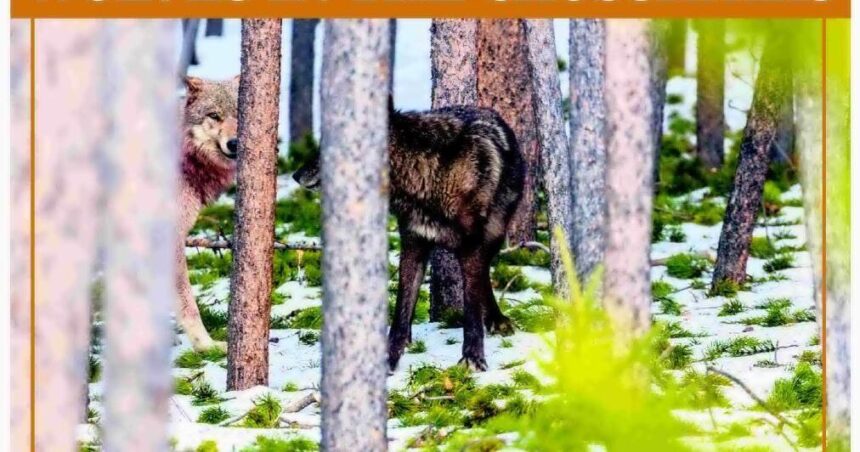Wolf hunting and trapping advocates will collide with state and national wildlife advocates for what will be a lively Montana Fish and Wildlife Commission meeting on Friday in the state’s capital.
The meeting was moved to a larger venue for what’s predicted to be a bigger crowd as both sides rally their supporters.
At the center of the debate is Fish, Wildlife & Parks’ proposal to allow the killing of almost one-third of the state’s wolf population in the 2024-25 season. That’s too many for some, and not enough for others.
Last season, hunters and trappers killed 286 wolves — 161 taken by hunters (56%) and 125 taken by trappers (44%), according to FWP’s 2023 wolf report. The year before, 254 of the big canines were shot or trapped. For the past five years, despite higher quotas, the wolf harvest has steadily declined.
People are also reading…
The state’s wolf population is estimated at 1,096 animals that live mainly in the western third of the state. The wolf harvest is heaviest in northwest Montana.
Two modifications on the agenda, proposed by Region 3 Commissioner Susan Kirby Brooke, come at the urging of Yellowstone National Park Superintendent Cam Sholly.
One would change a hunting district north of the park boundary from one unit to two, as it had been in the past. In addition, the proposal would allow the harvest of three wolves in each unit. The idea is to reduce the killing of wolves that spend most of their time in Yellowstone.
“It seems a reasonable compromise to have this small area of the entire state of Montana, where wolves have not caused any problems to other industries, and that have a major contribution to the local economy, to have fine scale management and lower quotas,” Yellowstone wolf researcher Kira Cassidy wrote to the commission.
Chris Morgan, vice-president for the Montana Trapper’s Association, disagreed. He wrote the commission saying there is “no biological justification” for such a change and that Yellowstone’s wolf population is thriving.
The other amendment would outlaw the use of any electronic motion-tracking device or mechanism which, in theory, could be used to locate radio-collared park wolves and kill them.
In the 2021-22 hunting season, 21 wolves that spent most of their time in Yellowstone were killed by hunters and trappers. Since then, the commission has agreed to reduce the harvest limits at the request of tourism-related businesses who estimated the park’s wolves generate more than $82 million in visitor spending annually.
Another agenda modification, this one from FWP, will move a decision on the wolf trapping season back to the next commission meeting on Oct. 10 to give FWP “additional opportunity to assess wolf trapping dates and where those dates would apply.”
In the past, the agency has been criticized by trappers for waiting until grizzly bears are hibernating before allowing trapping in occupied grizzly habitat, called a floating date. The idea was to avoid trapping any grizzly bears, which are protected under the federal Endangered Species Act.
Even if hunters and trappers were to kill all 334 wolves as FWP has proposed, the population would still be more than twice as many as the state’s GOP-dominated legislature wants to see on the landscape.
“The statewide wolf population is NOT BEING REDUCED AS DIRECTED BY THE LEGISLATURE!” Rep. Paul Fielder, R-Thompson Falls, wrote in an email to the Fish and Wildlife Commission.
It was Fielder and Sen. Bob Brown, R-Thompson Falls, who brought four wolf-related bills to the 2021 Legislature. The bills allow unlimited take of wolves on a single wolf hunting or trapping license, the use of bait while hunting or trapping wolves, and hunting of wolves on private lands outside daylight hours with use of artificial light or night vision scopes.
One bill also requires FWP to reduce the wolf population to a “sustainable” level. Although that word isn’t defined, a population of 450 wolves statewide is the target FWP has set.
Fielder also told the commission if “meaningful wolf population reductions” cannot be achieved by hunters and trappers, then the U.S. Department of Agriculture’s Wildlife Services should be considered as an option.
Wildlife Services is an agency contracted for decades to control and reduce predators across the nation, from coyotes to troublesome bears. If meaningful wolf population reductions are not occurring with licensed and regulated hunters and trappers, Fielder suggested FWP “should look at other options to meet Legislative Intent.”
Wildlife Services confirmed the loss of 32 livestock to wolves during 2023, including 23 cattle and eight sheep; and one livestock guard dog, according to FWP’s report.
The Montana Livestock Loss Board paid $42,842.22 for livestock that were confirmed by Wildlife Services as killed by wolves or probable wolf kills, the report added. In response, Wildlife Services killed 27 wolves for the depredations, “or to reduce the potential for further depredation.” Private citizens legally killed another four.
FWP has also reduced the cost of wolf hunting licenses in an attempt to increase participation. Money raised is used for wolf management and monitoring. Since 2009, wolf license sales have generated nearly $5.4 million.
The Montana Legislature’s adoption of regulations meant to increase the killing of wolves drew the attention of the U.S. Fish and Wildlife Service. The agency said Montana and Idaho, have “adopted laws and regulations designed to substantially reduce the gray wolf populations in their states using means and measures that are at odds with modern professional wildlife management.”
The statement was contained in the agency’s recent decision not to restore federal protections for wolves. Instead, the USFWS said it would create a “first-ever nationwide gray wolf recovery plan” by December.
The USFWS decision to not restore federal protections for wolves resulted in a lawsuit by environmental groups this past April. They argue the agency is relying on faulty wolf population estimates generated by the states to conclude the animals are doing well.
Montana uses a model based in part on wolf sightings by hunters, as well as wolf kills and other information to generate its population estimate. Detractors of the methodology say it overestimates the wolf population.
Since wolves were removed from federal protection, FWP estimates their population has declined by about 13%. “From 2019 – 2023, the population consisted of a 5-year average of 189 packs and 1,134 wolves per year,” the agency said in its most recent wolf report.
According to FWP’s own projections, if the annual wolf harvest were to range between 350 to 500 wolves a year, the population would fall below 450 animals statewide in three to five years.
Wolf hunting and trapping opponents have become increasingly vocal since the 2021 Legislature made regulation changes, which may be affecting nonhunters’ backing.
A survey conducted by the University of Montana and FWP, released in January, shows support for wolf hunting declining from 71% in 2012 to 58%.
Wolf advocates have stressed that hunters and trappers are in the minority and called for the Fish and Wildlife Commission to pay more attention to so-called nonconsumptive users of wildlife, even suggesting a stamp be sold to help pay for wolf management.
In a letter to the commission, WildEarth Guardians noted less than 1% of Montanans hunt or trap wolves. “MFWP and the Commission should stop focusing on managing for a tiny portion of the state population and instead consider the interests of the other 99+% of the public who do not engage in wolf hunting or trapping,” the group said.
So far, the commission has not responded to such calls, but was publicly reprimanded after a lawsuit filed by Wolves of the Rockies revealed commission members discussed wolf policy in a quorum outside of public meetings. A settlement of the lawsuit required the commission to take training on conducting public meetings, as well as revealing all email correspondence for a year.
Marc Cooke, president of the Wolves of the Rockies, submitted a letter to the commission once again calling for the end to wolf hunting and trapping.
“In conclusion, protecting wolves from being killed aligns with ecological, ethical, cultural, and economic arguments, supporting a multifaceted approach to wildlife conservation that benefits both the environment and humanity,” he wrote.
The commission meeting begins at 8:30 a.m. on Friday, Aug. 16, in the Capitol’s Room 317 in Helena and will also be available online at https://fwp.mt.gov/ aboutfwp/commission.





